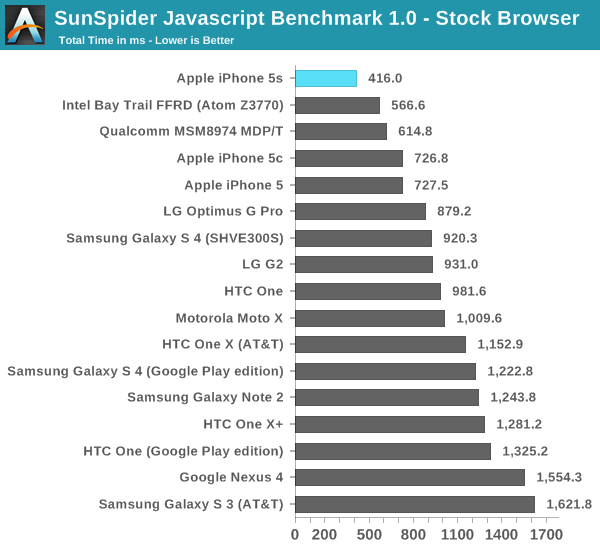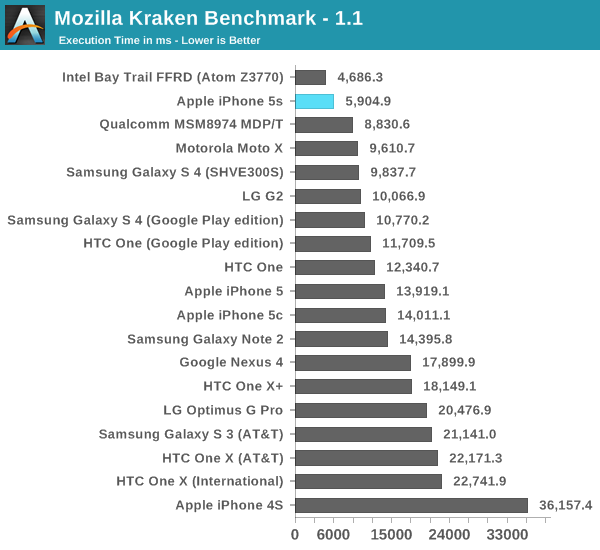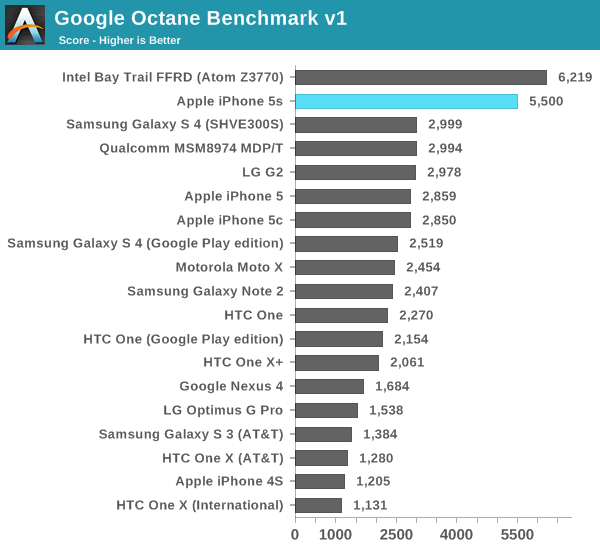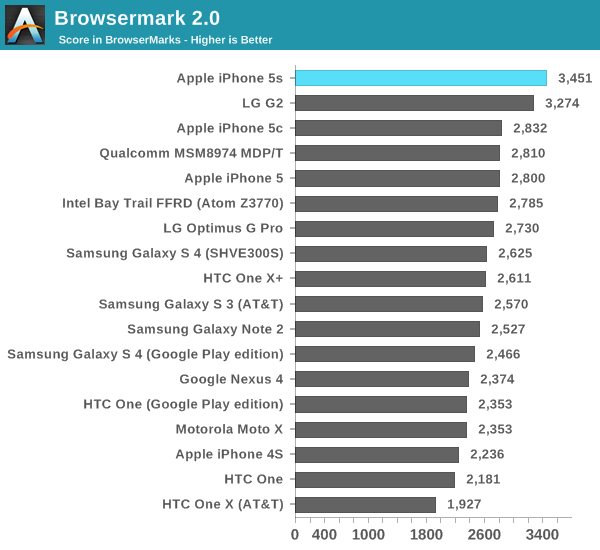The iPhone 5s Review
by Anand Lal Shimpi on September 17, 2013 9:01 PM EST- Posted in
- Smartphones
- Apple
- Mobile
- iPhone
- iPhone 5S
CPU Performance
For our cross-platform CPU performance tests we turn to the usual collection of Javascript and HTML5 based browser tests. Most of our comparison targets here are smartphones with two exceptions: Intel's Bay Trail FFRD and Qualcomm's MSM8974 Snapdragon 800 MDP/T. Both of those platforms are test tablets, leveraging higher TDP silicon in a tablet form factor. The gap between the TDP of Apple's A7 and those two SoCs isn't huge, but there is a gap. I only include those platforms as a reference point. As you're about to see, the work that Apple has put into the A7 makes the iPhone 5s performance competitive with both. In many cases the A7 delivers better performance than one or both of them. A truly competitive A7 here also gives an early indication of the baseline to expect from the next-generation iPad.
We start with SunSpider's latest iteration, measuring the performance of the browser's js engine as well as the underlying hardware. It's possible to get good performance gains by exploiting advantages in both hardware and software here. As of late SunSpider has turned into a bit of a serious optimization target for all browser and hardware vendors, but it can be a good measure of an improving memory subsystem assuming the software doesn't get in the way of the hardware.

Bay Trail's performance crown lasted all of a week, and even less than that if you count when we actually ran this benchmark. The dual-core A7 is now the fastest SoC we've tested under SunSpider, even outpacing Qualcomm's Snapdragon 800 and ARM's Cortex A15. Apple doesn't quite hit the 2x increase in CPU performance here, but it's very close at a 75% perf increase compared to the iPhone 5. Update: Intel responded with a Bay Trail run under IE11, which comes in at 329.6 ms.
Next up is Kraken, a heavier js benchmark designed to stress more forward looking algorithms. Once again we run the risk of the benchmark becoming an optimization target, but in the case of Kraken I haven't seen too much attention paid to it. I hope it continues to fly under the radar as I've liked it as a benchmark thus far.

The A7 falls second only to Intel's Atom Z3770. Although I haven't yet published these results, the 5s performs very similarly to an Atom Z3740 - a more modestly clocked Bay Trail SKU from Intel. Given the relatively low CPU frequency I'm not at all surprised that the A7 can't compete with the fastest Bay Trail but instead is better matched for a middle of the road SKU. Either way, A7's performance here is downright amazing. Once again there's a performance advantage over Snapdragon 800 and Cortex A15, both running at much higher peak frequencies (and likely higher power levels too, although that's speculation until we can tear down an S800 platform and a 5s to compare).
Compared to the iPhone 5, the 5s shows up at over 2.3x the speed of last year's flagship.
Next up is Google's Octane benchmark, yet another js test but this time really used as a design target for Google's own V8 js engine. Devices that can run Chrome tend to do the best here, potentially putting the 5s at a disadvantage.

Bay Trail takes the lead here once again, but again I expect the Z3740 to be a closer match for the A7 in the 5s at least (it remains to be seen how high the iPad 5 version of Cyclone will be clocked). The performance advantage over the iPhone 5 is a staggering 92%, and obviously there are big gains over all of the competing ARM based CPU architectures. Apple is benefitting slightly from Mobile Safari being a 64-bit binary, however I don't know if it's actually getting any benefit other than access to increased register space.
Our final browser test is arguably the most interesting. Rather than focusing on js code snippets, Browsermark 2.0 attempts to be a more holistic browser benchmark. The result is much less peaky performance and a better view at the sort of moderate gains you'd see in actual usage.

There's a fair amount of clustering around 2500 with very little differentiation between a lot of the devices. The unique standouts are the Snapdragon 800 based G2 from LG, and of course the iPhone 5s. Here we see the most modest example of the A7's performance superiority at roughly 25% better than the iPhone 5. Not to understate the performance of the iPhone 5s, but depending on workload you'll see a wide range of performance improvements.










464 Comments
View All Comments
stacey94 - Wednesday, September 18, 2013 - link
I'm sure Qualcomm and Google are in contact and work together on these things. Google seems have have moved almost exclusively to Qcom SoCs on their devices. If KitKat brings 64-bit and ARMv8 support, I'm sure Qualcomm knows about it and the next gen Snapdragons will take advantage of it.steven75 - Thursday, September 19, 2013 - link
This dude's got some SERIOUS Apple-envy.Btw, GarageBand, iPhoto, and iMovie will love the CPU headroom.
Eug - Wednesday, September 18, 2013 - link
Excellent review, Anand, as always. I too am getting an iPhone 5C, but re: iPhone 4 with iOS 7. I will say I was very pleasantly surprised by the performance of iOS 7.0 on the iPhone 4. I think it's very usable for UI navigation most of the time. There are occasional lags, but they were also there in iOS 6, albeit slightly less often in iOS 6. Where it really feels more consistently slow is internet surfing and the like. Overall though, my wife considers the iPhone 4 with iOS 7 to be reasonably speedy, because she does not do a lot of internet browsing on the phone, or gaming.Actually, a few things are actually a bit faster on the iPhone 4 in iOS 7 than iOS 6.1.3. For example, SunSpider 1.0.1 is about 2725 in iOS 7, but about 2975 in iOS 6. That's almost a 10% improvement.
So, while I personally would recommend nothing less than a 4S if getting a new phone for iOS 7, and preferably a 5C, for those existing users with the iPhone 4, don't throw it away just yet, because you might be surprised just how reasonable it is, especially if you are happy with it in iOS 6.
Eug - Wednesday, September 18, 2013 - link
Ooops. I meant I am getting a 5S. We geeks "need" the 5S, but slower iDevices are still quite usable. It's amazing just how much Apple has been able optimize iOS 7 for such ancient hardware.notddriver - Thursday, September 19, 2013 - link
I love that we live in a world where 2-3 years old counts as seriously ancient.ltcommanderdata - Wednesday, September 18, 2013 - link
Do you have any data on NAND speed improvements? ChAIR said level asset loading was 5x faster in the iPhone 5s during their Infinity Blade III demo. Is that just CPU/GPU/RAM based or also due to NAND speed? Faster NAND could also be contributing to the good photo burst mode performance and 720p120 video support.jeffkibuule - Wednesday, September 18, 2013 - link
I'm still wondering when Apple will be taking advantage of their Anobit acquisition. I'd like to see some real NAND controllers in iOS devices if they don't suck up tons of power.tipoo - Wednesday, September 18, 2013 - link
Yeah, I was curious about that, how did it get 5x faster? That seems too huge a jump for one NAND generation?pankajparikh - Wednesday, September 18, 2013 - link
Hi Anand big fan...can you confirm if the 5S supports LTE in India?rchangek - Wednesday, September 18, 2013 - link
You can get Hong Kong model A1530 that supports 39, 39, 40.These will support LTE bands 38, 39, 40 and I think Airtel is on band 40.
There are reports of (yet) unmentioned models for China A1516 and A1518 that will support bands 38, 39, 40 for LTE. However, it would be interesting to see if they will support UMTS alongside TD-SCDMA for 3G.
http://reviews.cnet.com/8301-6452_7-57602366/unann...